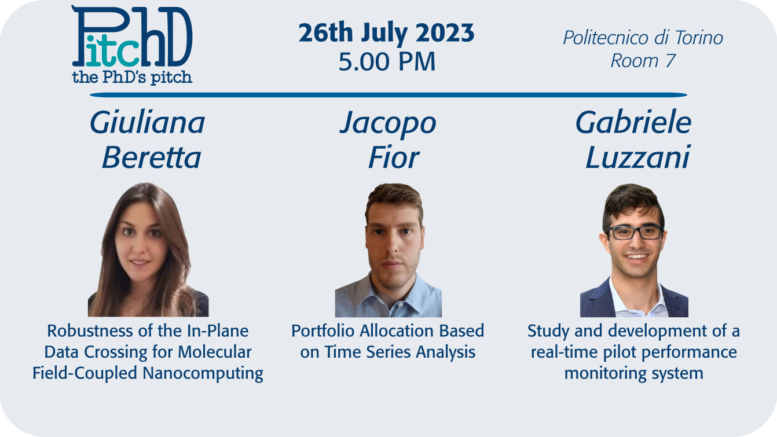26th July 2023 – 5.00 PM
Politecnico di Torino – Room 7
Here’s the 3rd PitchD – the PhD’s pitch. Our PhD IEEE Student Members explain to students, colleagues and professors their research in-presence. Please, remember that registration is required to attend the event.
Robustness of the In-Plane Data Crossing for Molecular Field-Coupled Nanocomputing
Ms. Giuliana Beretta
Dept. of Electronics and Telecommunications (DET), Politecnico di Torino
Biography: Giuliana Beretta attended the bachelor’s degree in Electronics and Telecommunication Engineering at the University of Brescia, where she graduated in September 2017. Then she received a master’s degree in Electronic Engineering (Microelectronics orientation) from Politecnico di Torino in April 2020, where she is now pursuing a Ph.D. in Electrical, Electronics, and Communications Engineering under the supervision of Prof. Gianluca Piccinini. Her research activities mainly focus on molecular nanotechnologies (with a particular interest in Field-Coupled Nanocomputing) for digital application and neural computing. Starting from the high-level constraints and parameters, she concentrates on the characteristics molecules should have to meet those requirements.
Abstract: Molecular Field-Coupled Nanocomputing (molFCN) presents several advantages over other beyond-CMOS technologies. These include reduced power dissipation due to the absence of charge transport and the ability to operate at room temperature. Previous studies have primarily focused on analyzing molFCN circuits from a behavioral perspective, while a few proposed solutions for crossing signals were examined from a logical and ideal viewpoint. However, information crossing is a crucial and intricate operation in molFCN, given its in-plane nature. Previous research has shown the significance of considering molecule physics to predict the behavior of molFCN circuits accurately. This study explores various implementations of in-plane information crossing interconnections, considering precise molecule physics to anticipate their functioning. By adjusting the electrostatic properties of the molecules involved, we assess the cross-wire’s robustness against static electrostatic variations. This analysis provides valuable insights for synthesizing custom molecules tailored for molFCN.
Portfolio Allocation Based on Time Series Analysis
Mr. Jacopo Fior
Dept. of Automation and Control Engineering (DAUIN), Politecnico di Torino
Biography: Jacopo Fior is a PhD candidate at the Department of Control and Computer Engineering of Politecnico di Torino. He obtained his Bachelor’s and Master’s Degree in Computer Science at UniTO (Università degli Studi di Torino), collaborated as a research assistant with the University of Helsinki and as a visiting PhD student with UCL (University College London). His main research interests are related to the study and application of machine learning and data mining techniques to time series data and, more specifically, to financial data.
Abstract: Planning buy-and-hold strategies for stock trading is a challenging financial task. It entails building a portfolio of stocks maximizing the expected return in the medium- or long- term while minimizing investments’ risk. An approach developed by Markowitz to select portfolios models the profitability and risk of stocks using a mean-variance model, which requires estimating numerous parameters. However, this poses concerns regarding the model’s reliability in real-world situations and necessitates significant computational effort. This study proposes a hybrid approach that combines itemset extraction with portfolio selection. The model logic of Markowitz’s approach is adapted to consider sets of candidate portfolios rather than individual stocks, reducing complexity and enabling the enforcement of portfolio-level constraints. Furthermore, diversification is commonly employed to manage risk in financial investments, spreading bets across multiple assets from different sectors. The framework presented also introduces a novel strategy based on time series clustering to enhance the effectiveness of stock diversification across sectors. By analyzing cross-correlations among price series, the strategy identifies groups of stocks displaying unexpected similarities across sectors and dissimilarities within the same sector. Experimental evaluation on the U.S. stock market verifies the approach’s flexibility, effectiveness, and scalability.
Study and development of a real-time pilot performance monitoring system
Mr. Gabriele Luzzani
Dept. of of Mechanical and Aerospace Engineering (DIMEAS), Politecnico di Torino
Biography: Gabriele Luzzani is a PhD student in Aerospace Engineering of Politecnico di Torino. His work concerns studying and developing a real-time pilot performance monitoring system based on physiological signals in collaboration with the research labs of Leonardo s.p.a.. His work is aligned with the increasing importance of Human-Machine Interaction systems in the aerospace sector.
Abstract: Two key challenges facing the aviation market today are rising operating costs, especially on short- and medium-haul flights, and the decreasing availability of pilots. Indeed, despite today’s regulations for most airline flights requiring a pilot and a co-pilot on board the aircraft to address these problems, there has recently been an increasing focus on the so-called Single Pilot Operations. However, the SPOs in aviation can be achieved only by guaranteeing the same (or higher) safety and handling quality level regulated to date in the EASA parts. Therefore, a cockpit assistant with the potential to understand the cognitive workload of the pilot and his ability/inability to operate the aircraft is a fundamental need to foster this disruptive transition. Our project aims to develop an autonomous Pilot Performance Monitoring system fully integrated into the cockpit that provides a continuous real-time output regarding the cognitive workload and the pilot’s state of health during the flight mission. It is based on a multimodal approach that considers the most significant physiological signals, such as cardiorespiratory measures, eye tracking, fNIRS (functional Near Infrared Signal), and skin activity, through ad-hoc developed electronics.
Download the flyer:
![]()


